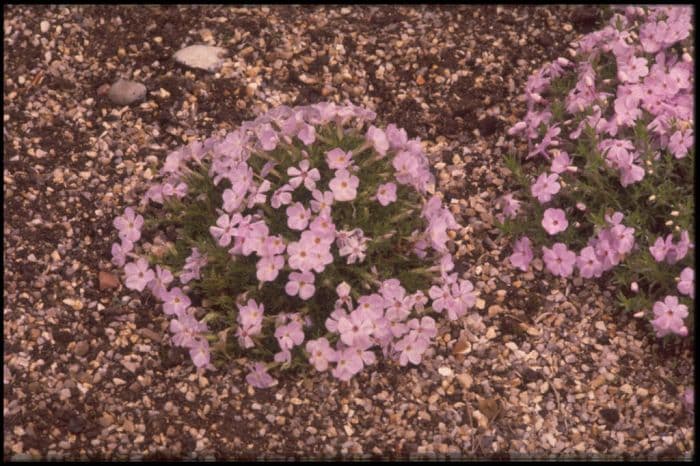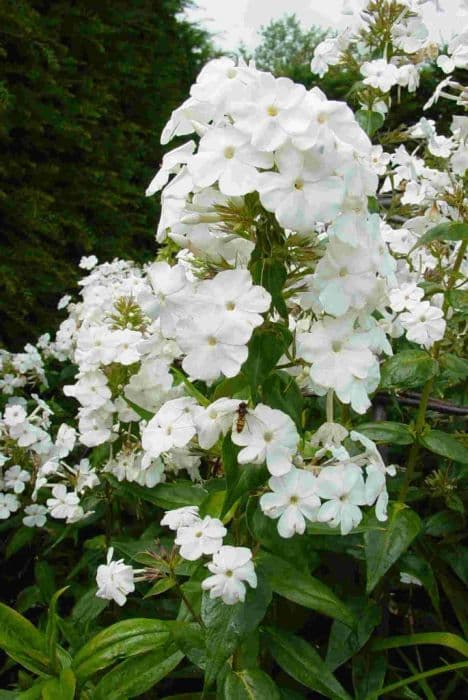Iceberg Phlox Phlox douglasii 'Iceberg'

ABOUT
The Iceberg variety of the flowering plant commonly known as creeping phlox, is distinguished by its stunning floral display and ground-hugging habit. This variety features a dense mat of small, needle-like evergreen leaves which provide a lush background for the masses of flowers it produces. The blooms of the Iceberg are particularly striking—pure white with delicate, petal edges occasionally kissed with a hint of pink or cream, giving them a frosted appearance. Each flower is composed of five, flat, petal-like lobes that are rounded at the tips. These blossoms are tightly packed, forming a carpet-like effect that can look like a blanket of snow covering the foliage. The contrast between the vibrant green of the leaves and the crisp white of the flowers is quite eye-catching, and when in full bloom, this plant is known for attracting various pollinators such as butterflies and bees. The visual appeal of the Iceberg is not just in its blooms but also in the lush greenery it maintains throughout the year.
About this plant
 Names
NamesFamily
Polemoniaceae
Synonyms
Douglas's Phlox, Iceberg Phlox, White Moss Phlox
Common names
Phlox douglasii 'Iceberg'.
 Toxicity
ToxicityTo humans
Douglas moss phlox is not commonly known to be toxic to humans. Most members of the Phlox genus are considered safe, and there is no widespread documentation or reports of significant toxicity in humans from ingestion or contact with Douglas moss phlox. However, as with any plant not designated for consumption, it's always possible for individuals to have allergic reactions or experience gastrointestinal discomfort if parts of the plant are ingested. If such symptoms occur, medical advice should be sought.
To pets
Douglas moss phlox is not commonly known to be toxic to pets. The Phlox genus is generally considered non-toxic for animals, and there is no prevalent evidence to suggest that Douglas moss phlox poses a significant risk of poisoning to pets. If a pet ingests this plant, they might experience mild gastrointestinal upset as they would with ingestion of non-food items, but severe toxicity is not expected. If adverse symptoms appear or if large quantities of the plant are ingested, it is recommended to consult with a veterinarian.
 Characteristics
CharacteristicsLife cycle
Perennials
Foliage type
Evergreen
Color of leaves
Green
Flower color
White
Height
0.5 feet (15 cm)
Spread
1 feet (30 cm)
Plant type
Herb
Hardiness zones
3
Native area
North America
Benefits
 General Benefits
General Benefits- Easy to Grow: Phlox douglasii 'Iceberg' is known for its hardiness and ease of cultivation, making it suitable for gardeners of all skill levels.
- Drought Tolerant: Once established, it has good drought resistance, which is ideal for xeriscaping and low-water gardens.
- Ground Cover: Its mat-forming habit helps to suppress weeds and cover bare spots in the garden.
- Attracts Pollinators: The flowers attract butterflies, bees, and other beneficial insects, supporting local ecosystems.
- Long Blooming: It has a lengthy blooming period which provides color from spring into early summer.
- Low Maintenance: It requires minimal upkeep once established apart from occasional watering and trimming.
- Frost Hardy: The plant is able to withstand cold temperatures, making it suitable for cooler climates.
- Colorful Foliage: The foliage often turns reddish or purplish in fall, adding additional seasonal interest.
- Versatile Planting Options: It can be used in rock gardens, as a border plant, in containers, or on slopes for erosion control.
- Aesthetic Appeal: Adds visual interest to the garden with its bright white flowers and dense green foliage.
 Medical Properties
Medical PropertiesThis plant is not used for medical purposes.
 Air-purifying Qualities
Air-purifying QualitiesThis plant is not specifically known for air purifying qualities.
 Other Uses
Other Uses- Phlox douglasii 'Iceberg', commonly known as Douglas's Phlox, can be used to create a natural dye for fabrics with its flowers, which can give a range of soft purple and pink hues depending on the mordant used.
- In garden design, Douglas's Phlox can serve as a living mulch, providing a dense vegetative layer that suppresses weeds and retains soil moisture.
- This plant, with its attractive carpeting habit, can be used to stabilize soil on slopes or embankments, helping to prevent soil erosion.
- In rock gardens, Douglas's Phlox can fill crevices between stones, adding color and life while also helping to keep the rocks in place.
- Beekeepers may utilize this plant in their gardens, as it's an excellent early source of nectar for bees in the springtime.
- Due to its dense growth, it can be used to provide a natural protective cover for ground-nesting insects and small wildlife.
- Photographers and artists can capture the beauty of Douglas's Phlox, using it as a subject in botanical illustrations and nature photography.
- It can be incorporated into sensory gardens, where its soft texture and vibrant blooms provide tactile and visual stimulation.
- Butterfly enthusiasts often plant Douglas's Phlox to attract butterflies, as it's a favored nectar plant for many species.
- With its low water requirements, it serves as an ideal candidate for xeriscaping, contributing to water conservation in landscaping.
Interesting Facts
 Feng Shui
Feng ShuiThe plant Phlox is not used in Feng Shui practice.
 Zodiac Sign Compitability
Zodiac Sign CompitabilityThe plant Phlox is not used in astrology practice.
 Plant Symbolism
Plant Symbolism- Harmony – Phlox douglasii, commonly known as Creeping Phlox, often symbolizes harmony due to its growth habit that forms a unifying carpet of flowers, blending with other plants in a garden space.
- Unity – The dense clusters of blossoms represent the coming together of many small parts to create a beautiful whole, embodying the idea of unity.
- Agreement – The consistent flowering pattern of Creeping Phlox signifies agreement, much like the way the flowers agree to bloom collectively and in harmony.
- New Beginnings – As a plant that blooms vigorously in spring, Creeping Phlox is emblematic of new beginnings and the renewal that comes with the season.
 Water
WaterCreeping Phlox should be watered regularly, especially during its growing season in spring and early summer. The soil should be kept evenly moist but not waterlogged. It's generally best to water deeply once a week, providing about one inch of water which equates to about 0.623 gallons per square foot. During periods of high heat or drought, you may need to water more frequently to maintain the moisture level. It is important not to let the soil dry out completely, but also avoid overwatering which can lead to root rot.
 Light
LightCreeping Phlox thrives in full sun to partial shade. It performs best and produces the most flowers when it receives at least six hours of direct sunlight each day. However, in hotter climates, some afternoon shade can be beneficial to prevent scorching. A spot that enjoys morning sunlight and is protected from the intense afternoon heat is ideal for this plant.
 Temperature
TemperatureCreeping Phlox is hardy and can tolerate a wide range of temperatures, but it grows best when daytime temperatures are between 60°F and 80°F. It can survive minimum temperatures down to -30°F and maximum temperatures up to 120°F. The ideal temperature range promotes healthy growth and abundant flowering.
 Pruning
PruningCreeping Phlox should be pruned to maintain its shape and encourage vigorous growth. It benefits from a trimming right after it has finished blooming, typically in late spring or early summer. This encourages a bushier growth habit and can help promote a second bloom. Remove dead or spent flowers, and cut back by about a third to encourage dense growth and rejuvenation.
 Cleaning
CleaningNot needed
 Soil
SoilThe Creeping Phlox prefers a well-draining soil mix with a neutral to slightly alkaline pH of 6.5-8.0. A mixture of garden soil, peat moss, and perlite in equal parts is often recommended to ensure good drainage and aeration, which is crucial for the health of this plant.
 Repotting
RepottingCreeping Phlox does not typically require frequent repotting. It can be repotted every 2-3 years or when it has clearly outgrown its current container and the roots have filled the pot. It's best to repot in the spring before new growth begins.
 Humidity & Misting
Humidity & MistingCreeping Phlox thrives best in average to dry humidity conditions. It does not require high humidity and will do well in the typical humidity levels found outdoors in its growing regions or indoors in a home environment.
 Suitable locations
Suitable locationsIndoor
Provide bright light and ensure good air circulation for Creeping Phlox.
Outdoor
Plant in full sun to partial shade in well-draining soil for Creeping Phlox.
Hardiness zone
3-9 USDA
 Life cycle
Life cyclePhlox douglasii 'Iceberg', commonly known as 'Iceberg' Creeping Phlox, starts its life as a seed that, with adequate conditions of soil and temperature, will germinate and sprout. After germination, it enters the vegetative stage, developing a mat-forming habit with semi-evergreen foliage. Through the spring and early summer, 'Iceberg' Creeping Phlox progresses to the flowering stage, showcasing masses of star-shaped, white flowers. Once pollinated, likely by insects attracted to its blooms, the plant sets seed, which is the reproductive stage of the life cycle. If the seeds are dispersed into a suitable environment, they will go dormant until the following spring, when the cycle starts anew. As a perennial, the vegetative and flowering stages recur annually, with the plant expanding in coverage and potentially living for several years under optimal conditions.
 Propogation
PropogationPropogation time
Spring-Early Summer
Phlox douglasii 'Iceberg', more commonly known as Douglas's phlox or simply Iceberg phlox, can be effectively propagated through the division of established clumps. This method is frequently employed by gardeners and is best done in early spring or autumn. Begin by gently digging up the parent plant, taking care not to damage its root system. Once excavated, carefully separate the clumps into smaller sections, ensuring that each new section has a good portion of roots attached. These sections can then be replanted into a well-prepared bed, spaced about 6 to 12 inches (approximately 15 to 30 cm) apart, and watered thoroughly to establish. By this means, the Iceberg phlox will quickly take root in its new location, and one can expect a vibrant display of blooms in the following growing season.









